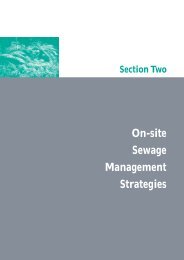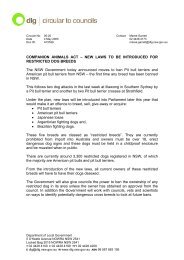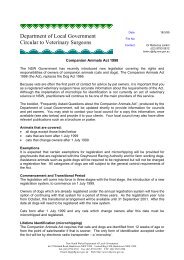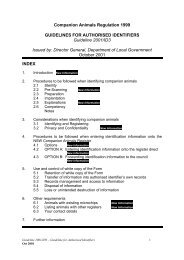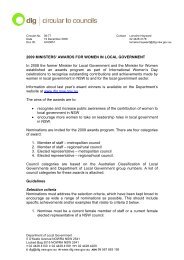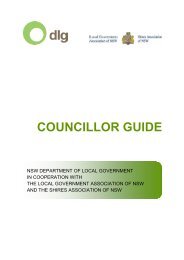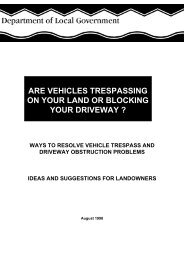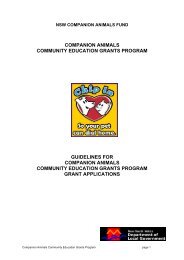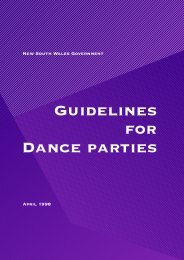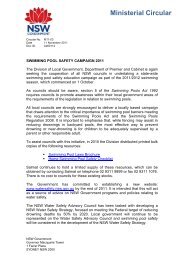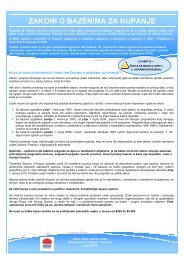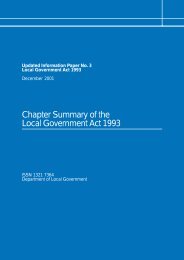Integrated Planning and Reporting Manual - Division of Local ...
Integrated Planning and Reporting Manual - Division of Local ...
Integrated Planning and Reporting Manual - Division of Local ...
You also want an ePaper? Increase the reach of your titles
YUMPU automatically turns print PDFs into web optimized ePapers that Google loves.
2. THE COMMUNITY STRATEGIC PLAN<br />
<br />
<br />
<br />
<br />
Places for People – which considered issues relating to the built environment <strong>and</strong> urban<br />
design<br />
A Prospering City – focusing on the city’s local <strong>and</strong> regional economic context <strong>and</strong> economic<br />
development issues<br />
Moving Around – which looked at transport issues <strong>and</strong> the social, l<strong>and</strong> use, economic <strong>and</strong><br />
sustainability issues that arise from how people move around<br />
Looking after our Environment – which gave an overview <strong>of</strong> the city’s local <strong>and</strong> regional<br />
natural environment <strong>and</strong> recreational context.<br />
This was one way <strong>of</strong> providing a sound basis for community discussion on key issues. Some<br />
councils use a ‘State <strong>of</strong> the Shire’ report to highlight key local issues. Some smaller councils have<br />
used innovative approaches to start discussion on long-term planning, such as collecting photos <strong>of</strong><br />
what people like <strong>and</strong> don’t like about their community.<br />
Drawing all this information together <strong>and</strong> presenting it in a user-friendly format is a considerable task<br />
<strong>and</strong> councils will need to approach the exercise according to their own particular circumstances. For<br />
example, a small rural council may only need one general discussion paper, or presentation to<br />
support its discussions. A large metropolitan council would need to take a more comprehensive<br />
approach. The important thing to remember is that this is an integrated planning framework – so<br />
relevant information will come from a variety <strong>of</strong> sources <strong>and</strong> the planning process will involve a<br />
variety <strong>of</strong> different people. Council should aim to gather the best available information.<br />
Although many councils currently have a strategic planning team, the pre-plan work shouldn’t be<br />
restricted to this team alone. The Community Strategic Plan will ultimately affect everyone who<br />
works at the council, as well as the community, so it is best to get a variety <strong>of</strong> people involved in the<br />
process.<br />
Part <strong>of</strong> the process will be to think about some <strong>of</strong> the possible impacts <strong>and</strong> implications <strong>of</strong> the issues<br />
that are identified. In this respect, it would be very valuable to have a range <strong>of</strong> people working on<br />
the project. For example, if you are considering waste management issues, engineering staff might<br />
highlight different implications to, say, community services practitioners, or financial managers, or<br />
members <strong>of</strong> a local environment group.<br />
Where will the team start in gathering information<br />
There are usually a couple <strong>of</strong> issues that are at the forefront <strong>of</strong> public debate. These generally relate<br />
to external pressures or changes that the community may be experiencing – for example in<br />
metropolitan communities the concern may be about managing growth <strong>and</strong> development in the<br />
area. For rural communities, it might be about ensuring the long-term survival <strong>of</strong> towns <strong>and</strong><br />
industries. Both communities might be concerned about the impacts <strong>of</strong> climate change, but for<br />
varying reasons.<br />
Communities are also concerned with quality <strong>of</strong> life issues – such as personal safety, open space<br />
<strong>and</strong> places for recreation, general amenity <strong>and</strong> aesthetics <strong>of</strong> the area, protection <strong>of</strong> the environment,<br />
employment <strong>and</strong> educational opportunities.<br />
The challenge is to drill down into these general issues <strong>and</strong> identify some specifically local<br />
concerns: What is the current state <strong>of</strong> play What are the likely impacts <strong>and</strong> implications<br />
It is also important to identify <strong>and</strong> underst<strong>and</strong> the drivers <strong>of</strong> change. What are the pressures or<br />
influences that will affect the community <strong>and</strong> bring about the expected changes Can we do<br />
anything about them Are there any opportunities that could be explored<br />
<strong>Planning</strong> & <strong>Reporting</strong> <strong>Manual</strong> Page 29 <strong>of</strong> 115



